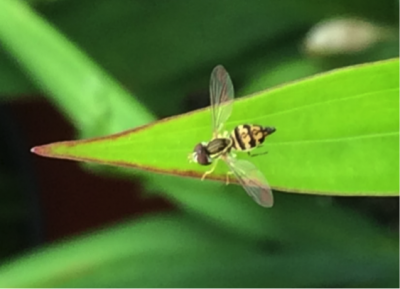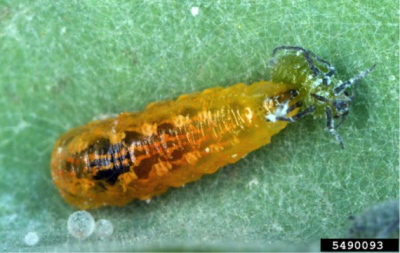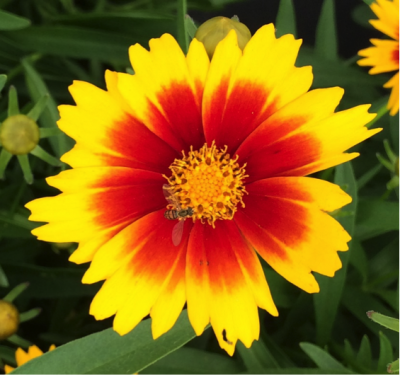Donna Ellis, UConn, Department of Plant Science and Landscape Architecture, 2017.
Syrphid flies are also known as hover flies or flower flies. These tiny beneficial insects are members of the insect order Diptera, which includes flies, mosquitoes, and gnats. They adults vary in size, but the common ones we often see in our area are less than ¼ inch in length. Syrphid flies have 2 wings and are sometimes mistaken for small bees due to similar markings on their abdomen, but they are flies and do not bite or sting. Syrphid flies are amazing pollinators, feeding on pollen and nectar from many annuals and perennials during the summer months. These beneficials are called hover flies because they can actually hover over plants while flying.
Syrphid flies go through complete metamorphosis, from egg to larva (the larva are technically called maggots because they are flies), on to a pupal stage, and finally to adult. As an immature larva, they can feed on many soft-bodied plant pests, such as aphids, eggs, scales, caterpillars, and leafhoppers. The larvae can be found in many colors, including green, brown, yellow, or off-white. To find their prey, larvae move their legless bodies around on plants and swing their heads until they bump into their next meal. Despite their small size, a syrphid fly larva can feed on hundreds of insects before it develops into an adult. The adults only feed on pollen and nectar. There can be a number of generations of these helpful insects during the summer months. Look for them on the flowers in your garden!

beneficial insects are often found hovering over flowers.
Photo by Donna Ellis, UConn.

Photo by David Cappaert, Michigan State University, Bugwood.org.

you will see a tiny adult syrphid fly.
Photo by Donna Ellis, UConn.
References
Gardiner, M.M. 2004. Good Garden Bugs. Everything You Need to Know About Beneficial Predatory Insects. Quarry Books, Beverly, MA. 176 pp.
Walliser, J. 2014. Attracting Beneficial Bugs to Your Garden. Timber Press, Portland, OR. 240 pp.